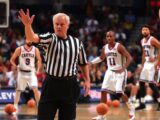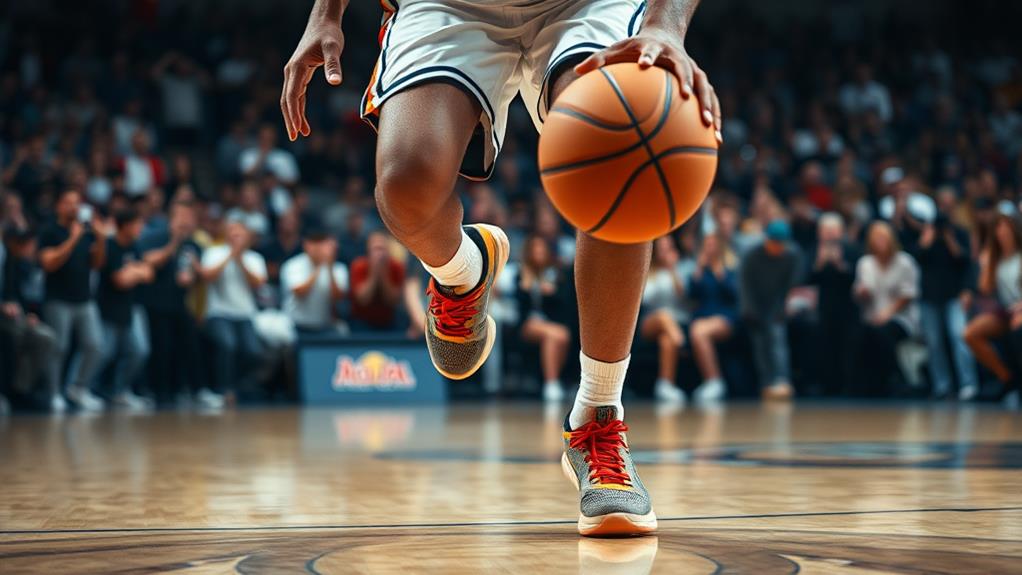
The Gather Step in Basketball: A Rule Breakdown
September 15, 2024The gather step is key in basketball, helping you smoothly shift from dribbling to shooting or passing. It includes a "zero step" plus two legal steps, essential for avoiding traveling violations. In the NBA and FIBA, it's allowed and can boost your offensive game. However, high school and college rules are stricter, so be aware of those differences. Misunderstanding this step is common, especially with slow-motion replays. Mastering it can enhance your footwork and scoring opportunities, just like stars such as Giannis and Harden. There's a lot more to explore about its impact on your gameplay.
Definition of the Gather Step
The gather step is an essential concept in basketball that allows you to take an extra step when shifting from dribbling to shooting or passing. When you pick up your dribble, the first step you take is often called the "zero step." After that, you're allowed to take two additional steps, making the gather step critical for executing plays without committing a traveling violation.
This concept is somewhat similar to understanding effective player selection in soccer, as both require a keen awareness of movement and timing. For young players, mastering the gather step is important. It not only helps you to improve your footwork but also enhances your ability to perform layups and advanced moves like step-backs legally.
Confusion often arises during slow-motion replays, where fans mistakenly count extra steps. Remember, the legality of the gather step hinges on the simultaneous movement of your hands and feet.
As you practice, focus on how the gather step allows you to shift smoothly from dribbling to shooting or passing. Understanding this concept will elevate your gameplay and help you stay compliant with the rules, ultimately making you a more effective player on the court.
Legality in Different Leagues
When you're playing in the NBA, the gather step gives you an extra advantage, allowing for a third step after picking up your dribble.
This technique can be strategically analyzed through data-driven approaches to enhance offensive efficiency and shot selection, as seen in the impact of analytics.
In contrast, high school rules don't allow this, treating it as a travel instead.
FIBA's recent changes align more closely with the NBA, making the gather step a legal move internationally, but it's crucial to know the rules for each league you play in.
NBA Rule Framework
Understanding the gather step in basketball can be confusing, especially since its legality varies across different leagues. In the NBA, the gather step is allowed, giving players an additional third step after they pick up their dribble. This contrasts sharply with high school and college basketball, where the gather step is often viewed as a traveling violation.
When players initiate the gather step, they start with a "zero step" right after stopping their dribble, followed by two legal steps before they can shoot or pass. This technique is vital for creating space and making plays, but it often leads to misunderstandings about traveling violations, especially during slow-motion replays where fans might miscount steps.
Moreover, the interpretation of the pivot foot rules differs in the NBA compared to lower levels. In the NBA, players can allow their pivot foot to touch the ground before shooting or passing, which isn't the case in high school or college.
Understanding these distinctions is essential for grasping the legality of the gather step across various leagues and avoiding confusion during games.
FIBA's Early Adoption
Prior to the NBA's adoption of the gather step, FIBA recognized its potential to enhance the flow of the game, legalizing it in 2018. This change allowed for a more fluid offensive style in international play, giving players greater rights reserved in how they approached scoring opportunities.
Here's what you need to know about the gather step:
- It adds an extra third step after the initial dribble stop in the NBA.
- In high school and college, the gather step is considered a travel, as they adhere to a stricter definition of a normal step.
- Differences in pivot foot rules can lead to confusion, with the first foot down after a dribble designated as the pivot in lower leagues.
The adoption of the gather step in FIBA paved the way for the NBA to follow suit, transforming offensive efficiency in professional basketball.
While some might argue that NBA players travel frequently, this perception is misleading; the gather step is an accepted and legal maneuver that changes how players strategize on the court.
Embracing this rule enhances the overall excitement and pace of the game.
High School Regulations
The gather step, while enhancing gameplay in the NBA and FIBA, presents a different set of rules at the high school level. In high school basketball, the gather step is seen as a traveling violation. This means you can't use it the way players do in professional leagues.
Understanding how your pivot foot works is vital, as the first foot that touches the ground after a dribble becomes your pivot foot.
High school players face stricter traveling rules, limiting their movement options compared to the NBA. This can lead to confusion, especially when you try to mimic moves from your favorite pro players who utilize the gather step legally. If you attempt to incorporate this move, you might find yourself whistled for a traveling violation, which can be frustrating during a game.
To avoid penalties, it's important to grasp the differences in traveling rules across leagues. Familiarizing yourself with these regulations can help you adapt your playing style accordingly, ensuring you stay within the rules while maximizing your performance on the court.
Players Utilizing the Gather Step
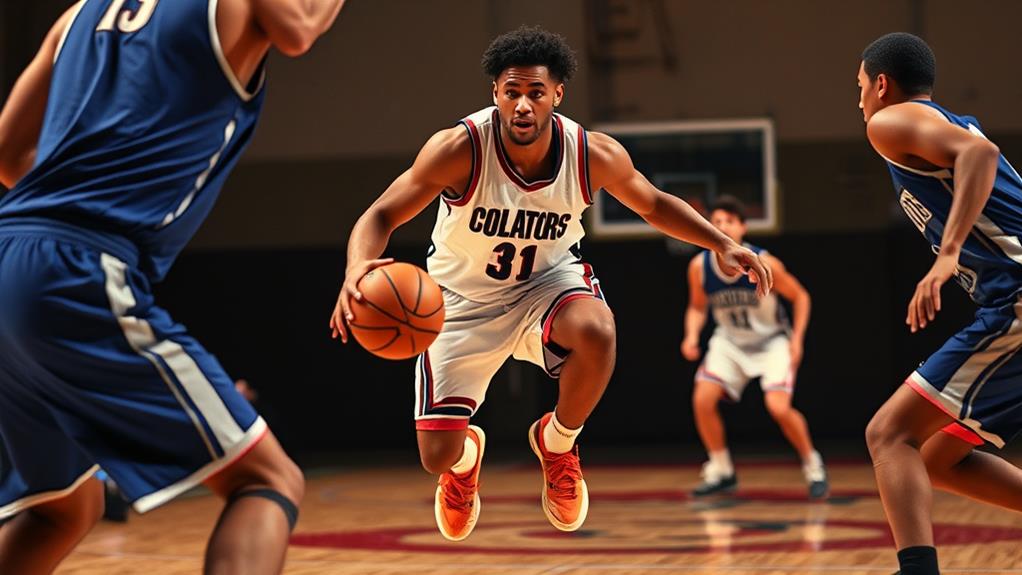
When you watch players like Giannis Antetokounmpo and James Harden, you'll see how they master the gather step to elevate their game.
The gather step allows players to maintain control while setting up their next move, similar to how soccer players use sportsmanship and respect to enhance team dynamics.
Giannis uses it for explosive drives, while Harden's step-back jumpers spark debates about their legality.
Both players demonstrate how this technique can create space and enhance scoring opportunities, similar to the Euro step.
Giannis's Explosive Drives
Utilizing the gather step, Giannis Antetokounmpo showcases explosive drives that leave defenders scrambling. As a skilled ball handler, he often employs this technique to cover significant ground quickly, maneuvering through defenders with ease. This ability to integrate the gather step into his game enhances his offensive efficiency, allowing him to finish at the rim with both power and finesse.
When you watch Giannis, you'll notice:
- He maximizes his height and wingspan, making it tough for opponents to contest his shots.
- His explosive drives come from a blend of speed and the gather step, creating separation effortlessly.
- The gather step aligns perfectly with NBA rules, giving him an advantage that few players can replicate.
This technique not only contributes to his scoring ability but also makes him a dominant force in the league.
While many players may rely on a step back to create space, Giannis's gather step allows him to maintain momentum and pressure on the defense. His unique style has redefined how to utilize this rule, proving that the gather step can be a game-changer for anyone looking to elevate their game.
Harden's Step-Back Controversy
James Harden's offensive arsenal often sparks heated discussions, particularly regarding his step-back jump shots and the legality of his gather step. You've probably seen him create space with this technique, allowing him to evade defenders and launch his shot.
However, this move often raises eyebrows about whether he's violating traveling rules. The gather step permits Harden to take an extra step after picking up his dribble, a maneuver that's tricky to judge.
When you watch it in slow motion, it can certainly look like traveling, which fuels debates among fans and analysts. Defenders frequently struggle to adjust to his unique style because he combines the gather step with deceptive dribbling, making it hard to discern if he's committed a travel violation.
What makes this situation even more interesting is how the gather step highlights the differences in traveling rules across basketball leagues. While Harden's moves are celebrated in the NBA, they'd likely be ruled as traveling in high school or college games.
This discrepancy adds another layer to the ongoing conversation about the legality of step-back jump shots in professional basketball.
Euro Step Similarities
The Euro step and gather step are both dynamic moves that highlight players' agility and creativity on the court. While they may seem distinct, they share key similarities, especially in how they allow players to evade defenders during a drive to the basket.
- The Euro step involves a horizontal jab followed by a push-off in the opposite direction.
- The gather step creates space, enabling players to cover significant ground quickly.
- Both moves can be interpreted differently across leagues, affecting their legality.
Players like Manu Ginóbili set the standard for the Euro step, while modern stars like Giannis Antetokounmpo use the gather step to enhance their explosive drives.
Giannis's ability to navigate through defenders mirrors the effectiveness of the Euro step. Similarly, James Harden has incorporated the gather step into his step-back shots, generating debate over the legality and complexity of his moves.
In essence, whether you're executing a Euro step or a gather step, mastering these techniques won't only elevate your game but also keep defenders guessing as you drive towards the hoop.
Comparison With Euro Step
When comparing the gather step to the Euro step, you'll notice distinct differences in how each maneuver is executed and perceived within the game. The gather step allows you to take an extra step after stopping your dribble, giving you more flexibility while driving to the basket. This is particularly vital as the sport continues to grow globally and players from diverse backgrounds bring unique playing styles, enhancing the overall competitiveness of the game.
In contrast, the Euro step involves a horizontal jab step followed by a push-off in the opposite direction, letting you evade defenders effectively.
While both the gather step and Euro step aim to create space for scoring, they differ in the number of legal steps used. The Euro step typically includes two steps after the initial jab, making timing and coordination essential. This has led to some controversy about its legality, especially when executed quickly.
Global basketball expansion has contributed to the evolution of these techniques, showcasing their effectiveness across various leagues.
Manu Ginóbili popularized the Euro step, showcasing its effectiveness even under stricter travel rules. If you're looking to create scoring opportunities, mastering both the gather step and Euro step will enhance your gameplay.
Misconceptions About Traveling
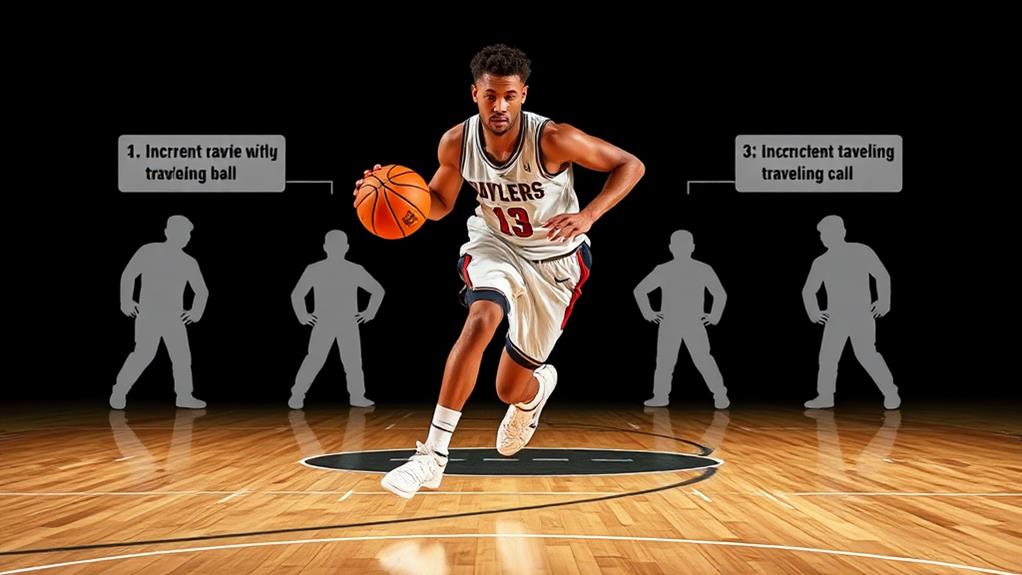
Misconceptions about traveling often cloud fans' understanding of basketball rules, particularly regarding the gather step. Many people see players take what appears to be extra steps, especially during slow-motion replays, leading to confusion.
The evolution of the game, including changes in rules and player movements, has made it vital to recognize that the gather step is a legal move in the NBA and FIBA, though high school and college basketball rules treat it differently. In fact, the introduction of more advanced rules about player movement, such as the gather step, reflects ongoing efforts to enhance fairness in gameplay standardization of court dimensions.
Here are a few common misconceptions:
- The gather step is always a travel.
- The first step after picking up the dribble isn't counted.
- Players can take a step without control of the ball.
Understanding that the first step after a dribble is technically a "zero step" is essential. It's the movement that follows the gather that counts toward the traveling rule.
When players like James Harden and Giannis Antetokounmpo execute their moves, it's easy to misinterpret their actions as traveling. However, as long as their hands and feet synchronize correctly, they're playing by the rules.
Legal Moves Demonstrated
Understanding the legal moves in basketball is essential for appreciating the game's flow and strategy. One of the most significant aspects is the gather step, which allows you to shift smoothly from dribbling to shooting. As the game evolves, so do the tactics employed on the court, with adaptability in defensive strategies becoming increasingly important.
For a legal layup, you start with a dribble, then perform a gather step by placing the ball in both hands. This is where your foot placement becomes critical, as the last dribble counts as your first step in the traveling sequence, enabling you to take two more steps without committing a violation.
It's important to maintain proper dribble coordination during this process. As you gather the ball, your hands must touch it while your feet are in motion. This synchronization prevents traveling calls and keeps your play clean.
Speed doesn't affect the legality of the gather step; what matters is that the gathering and your steps happen simultaneously. You can even execute advanced moves like a windmill or step-back legally, provided you follow the gather mechanics and keep your dribble intact.
Mastering these legal moves will enhance your gameplay and help you maneuver effectively on the court.
Advanced Techniques and Moves
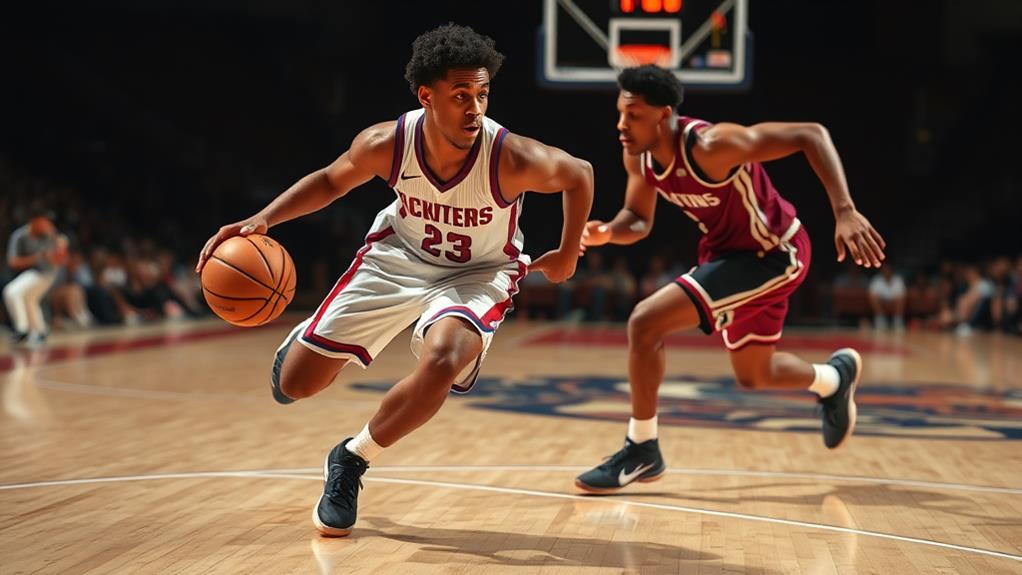
When you're looking to elevate your game, mastering advanced techniques like the windmill move and step-back execution is key.
These moves not only showcase your skills but also keep defenders guessing. Understanding the gather step is essential, as it allows players to maintain legal dribbling while creating space for effective scoring opportunities, much like how centers contribute to team dynamics with their offensive versatility and ability to draw defensive attention the importance of centers.
Legal Step-Back Execution
Although executing a legal step-back can seem challenging, mastering this move is essential for creating space and scoring opportunities. To perform a successful step-back without traveling, you need to synchronize your gathering of the ball with your foot movements. Remember, the last dribble counts as the first step in this legal sequence.
Here are some effective step-back strategies:
- Use a behind-the-back dribble to create separation.
- Maintain rhythm and timing while shifting your weight.
- Focus on offensive spacing to read your defender's movements.
When you gather the ball with both hands, you can take two additional steps, allowing for that vital distance needed to shoot.
Mastering dribble techniques is key; it helps you maintain control while you execute the move. As you practice, pay attention to how your body shifts and how quickly you can create space from your defender.
With enough repetition, you'll find that the step-back becomes a reliable weapon in your offensive arsenal, helping you score more effectively while staying within the rules of the game.
Mastering Windmill Moves
Mastering windmill moves can take your game to new heights, literally and figuratively. To execute this stunning maneuver, you need to grasp the windmill mechanics, which involve swinging the ball over your head while gathering. Start by ensuring your hands are on the ball during the shift from dribble to gather; this vital step prevents traveling violations.
Timing and rhythm are essential for a successful windmill. Practice timing drills to synchronize your footwork and ball movement, allowing for a fluid and legal execution. Remember, the key to a powerful finish lies in the coordination of your gather and subsequent steps.
Additionally, selling the move with body feints can make a significant difference. Use these feints to mislead defenders, creating space for your explosive finish at the rim. Mastering body feints alongside your windmill mechanics will make you more unpredictable and harder to defend against when driving to the basket.
Incorporate these techniques into your training regimen, and you'll find that your offensive arsenal expands, making you a more formidable player on the court.
Keep refining these skills, and soon enough, you'll be throwing down impressive windmill dunks with confidence.
Role of Experience in Rules
Experience plays an essential role in understanding the rules of basketball, particularly in executing movements like the gather step. The more you play and practice, the more you internalize the nuances of the game.
This experience benefits players and referees alike, enhancing their ability to discern legal moves from illegal ones. Importantly, soccer moves guide offers insight into similar skill mastery that can be applied across sports.
- With extensive practice, you develop a better rhythm and feel for executing complex maneuvers without traveling.
- Referee training focuses on recognizing these subtleties, allowing officials to make quicker, more accurate calls during fast-paced play.
- As you gain experience, your player awareness improves, reducing disputes over traveling calls.
Impact on Offensive Play
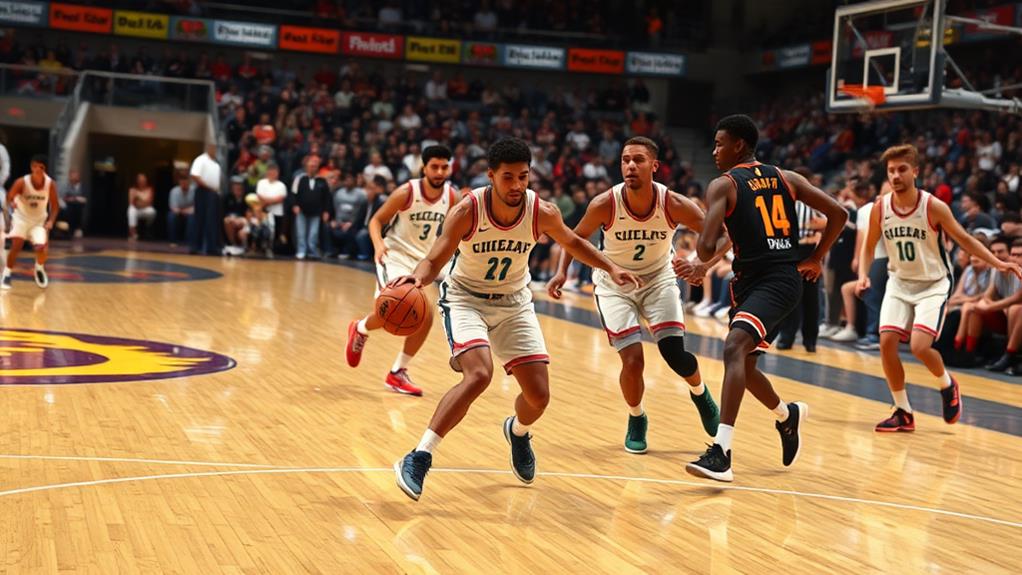
The gather step greatly impacts offensive play by allowing players to maximize their movement toward the basket. This extra third step, permitted in the NBA, lets you drive without the fear of being called for traveling. When you watch players like Giannis Antetokounmpo, you see how effectively he covers ground quickly, leading to explosive drives that greatly boost scoring efficiency.
By understanding the rules surrounding the gather step, teams can develop smart offensive strategies that exploit scoring opportunities within regulations.
Incorporating the gather step into your offensive strategies can create more dynamic scoring opportunities. It keeps defenses off-balance, making it harder for them to predict your next move. This enhanced ability to maneuver also plays a vital role in player development, as young athletes learn to exploit this rule effectively.
However, it's essential to recognize that the legality of the gather step varies across different levels of play. In high school and college, it's often seen as traveling, which can impact how young players approach their offensive game.
Mastering the gather step is essential for you to excel in the modern game, as it contributes to faster-paced, more entertaining basketball. Embracing this technique can elevate your game and your team's overall performance.
Learning From Professionals
Many young players look to professionals for guidance on mastering the gather step, but they often face challenges due to the varying rule interpretations at different levels.
For instance, high school and college leagues might consider it a travel, while the NBA embraces the extra step. To overcome these hurdles, it's essential to focus on professional techniques that highlight the gather step's importance in offensive play.
- Observe how stars like Giannis Antetokounmpo and James Harden use the gather step effectively.
- Pay attention to the simultaneous action of hands and feet to avoid traveling violations.
- Analyze the rhythm execution during games to understand how top players maintain flow while moving.
Conclusion
To sum up, understanding the gather step can transform how you play basketball. You might think it complicates the game, but mastering this rule actually opens up your offensive options. By using the gather step effectively, you can create space and drive to the basket with confidence, just like the pros. So, don't shy away from incorporating this move into your game; embrace it and watch your skills elevate to new heights!


